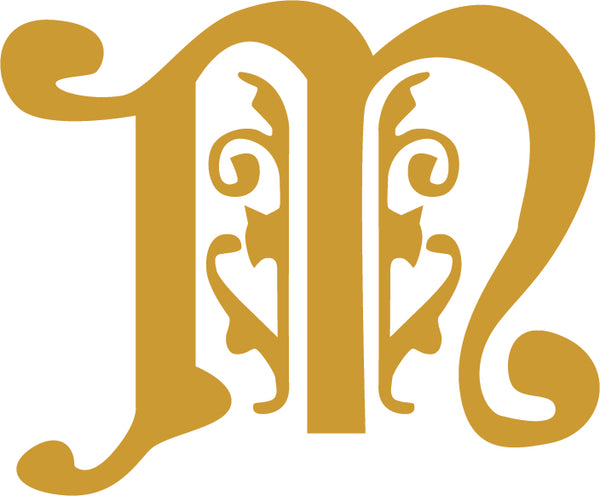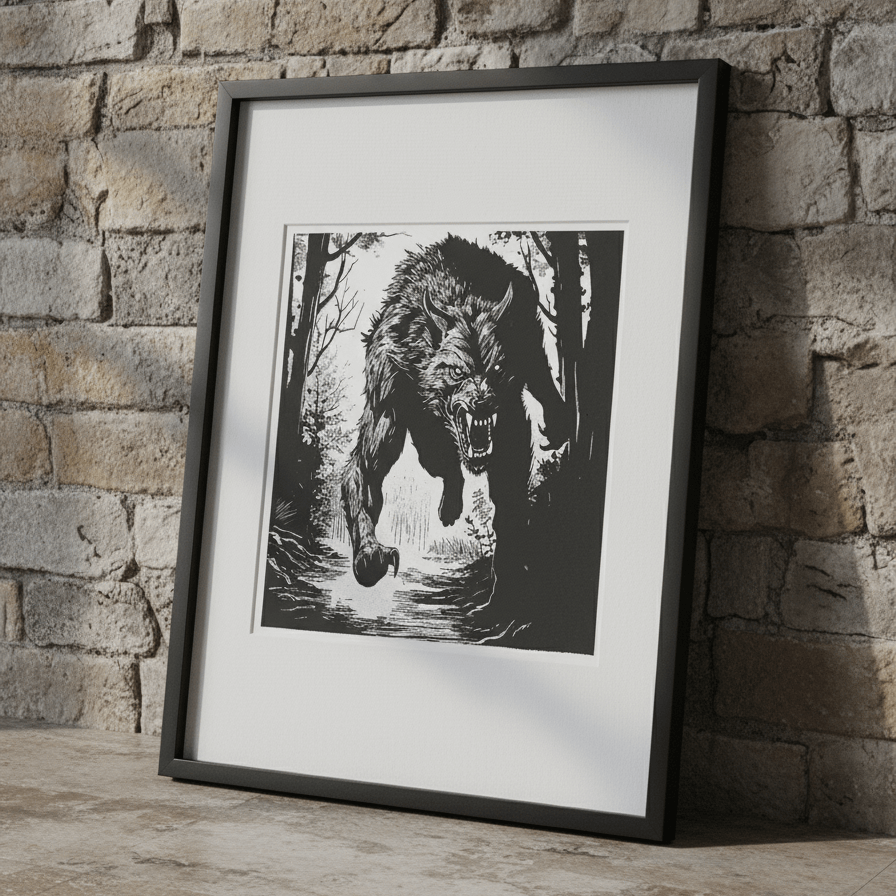
The Beast of Bray Road: Carving a Legend into Ink and Myth
There’s a road in southeastern Wisconsin—quiet, wooded, and unassuming. Its name? Bray Road. Its legacy? Far from ordinary.
Locals speak of a shadowed figure, half-wolf, half-man, that prowls the roadside. Some say it stands upright. Others claim it has the haunches of a bear and the stare of a demon. The stories change, but the chill they leave behind does not.
This is the Beast of Bray Road—and it’s the subject of one of the most haunting pieces I’ve ever carved.
A Wisconsin Legend, Born in Whisper and Fear
The legend of the Beast of Bray Road isn’t ancient in the way some folklore is, but it carries that same primal weight. First reported in the late 20th century, particularly around the 1980s and 1990s, the creature has been described as a werewolf-like beast. Sightings clustered around Elkhorn, Wisconsin—just over an hour from where I carve and print.
Witnesses recounted seeing a large, bipedal creature, often at night, often near fields or forests. It had glowing eyes. It growled. It chased. Some said it lunged at their cars. Others found mysterious animal remains—mutilated livestock, eerie tracks, fur that didn’t belong.
Local journalist Linda Godfrey investigated the accounts and eventually published The Beast of Bray Road: Tailing Wisconsin’s Werewolf in 2003. Her book gave voice and legitimacy to these whispers, positioning the Beast not just as a monster, but as part of the cultural fabric of the Midwest—a living piece of American cryptid lore.
And like many legends, the more people talked about it, the more real it became.
Why I Chose to Carve the Beast
When I first heard the tale, it didn’t immediately become an art piece. It lingered in my periphery—one of those stories you think about when you drive down a dark road at night, or when your dog growls at an empty doorway.
But eventually, it called to me. Not just as an artist—but as a Wisconsinite, a folklorist, and a printmaker devoted to recording stories that might otherwise vanish.
The Beast of Bray Road isn’t just a scary tale. It’s about the boundary between the seen and unseen. About fear rooted in landscape. About how communities respond to the unknown. And that’s what intrigued me most.
My work at Modern Medieval Press has always been about bridging past and present. I carve wood and linoleum the way scribes once carved saints and serpents. I ink broadsheets the way medieval monks inked their truths. So how could I not capture this modern myth with the tools of the old world?
Behind the Print: Ink, Intuition, and Architecture of Fear
The piece itself, now on exhibition as part of the International Dark Folklore Exhibition at the Cornwall Museum & Art Gallery, is carved in the style of a medieval bestiary—those illuminated manuscripts that catalogued the creatures of the world, both real and imagined.
But rather than placing the Beast on a decorated page, I set it loose in a carved forest—caught mid-lunge, jaws open, eyes locked on something beyond the frame. You, perhaps.
The shadows are deep, like cathedral vaults. The linework tense, with fur rendered in jagged texture, almost vibrating. The forest presses close, offering no escape. This is a creature born not just of tooth and claw—but of story. Of newspaper broadsheets and midnight radio. Of bonfires and dare-you-to-go-down-that-road dares.
It’s not nostalgia I’m reaching for here. It’s preservation. This creature belongs in a bestiary—not because it’s ancient, but because it’s enduring. And so I carved it not just to depict the Beast, but to record it. To join the lineage of artists who have always been the keepers of lore.
Modern Medieval Press: Keeping Folklore Alive, One Carving at a Time
If you’re new here, welcome. Modern Medieval Press is my studio—a little portal where the past and present shake hands. Everything I make—be it a dragon print, a moonlit charm, or a snarling cryptid—carries a kind of echo. It’s a reminder that art has always been how humans make sense of the unknown.
In medieval Europe, woodcut artists illustrated everything from morality plays to miracle stories. These prints weren’t just decoration—they were communication. Visual storytelling for a largely illiterate population. And just like today, they were steeped in symbolism, awe, and warnings.
The Beast of Bray Road is no different. It belongs in this lineage. A creature of the margins. A thing you carve when you don’t have the words for what’s stalking you.
That’s what Modern Medieval Press is about. Using ancient techniques to tell modern stories. Elevating folklore as art. Treating the strange and liminal as sacred. Whether I’m hand-printing bookmarks, carving full exhibition pieces, or writing about moon cycles—each thing is an offering. A chance to pause, wonder, and remember.
On Display: A Haunting Journey Across the Sea
When I submitted this piece to the International Dark Folklore Exhibition, I didn’t expect it to be chosen. The show is hosted by Dark Cornwall and the Gothe Residency of the Arts—two organizations that honor the storytelling power of artists working in the realm of myth, memory, and shadow.
But then came the email. My breath caught. And I knew this beast had found its home.
There’s something poetic about a Midwestern monster now howling quietly in a UK gallery—hanging alongside selkies, bogeymen, and banshees. It's a reminder that folklore transcends geography. That mystery is a universal language.
The exhibition itself opens on August 16, 2025, in Cornwall. If you’re nearby, step into that space. Walk among the story-keepers. See how fear, beauty, and legend are carved into every piece. And if you’re far away—know that the magic still ripples outward.
Why the Beast Still Matters
You might wonder: Why give this much attention to a creature that may or may not exist?
Because belief is powerful. Because folklore is a mirror. Because stories like this reveal more about us than about the monsters themselves.
The Beast of Bray Road has never been "proven." And yet the reports continue. The sightings evolve. The drawings get sharper. The legend breathes.
And as long as people gather to tell the tale—as long as artists carve, paint, or sing it into being—it exists. Not just on Bray Road, but in the minds of those who wonder what moves just out of sight.
This weekend, at a local event, I spoke with people who live in the region where the Beast has been seen. Their stories weren’t pulled from books or podcasts—they were lived. One person recalled finding horses with their throats slit. Others mentioned strange animal mutilations with no clear explanation. These aren’t just spooky stories—they’re accounts shared in quiet tones, with eyes scanning the treeline.
It reminded me that folklore is alive. It’s not just what’s written down—it’s what’s whispered over tables, passed between neighbors, spoken just above a hush.
That’s why I carved it.
That’s why I’ll keep carving.
Learn More About the Beast
Curious to dive deeper into the lore? Here's where you can begin:
The Beast of Bray Road: Tailing Wisconsin’s Werewolf by Linda S. Godfrey
Podcasts like Monsters Among Us and Lore also feature compelling retellings.
And if you’d like to see the print in person—stay tuned. After the exhibition, I’ll be offering a limited number of hand-pressed editions here at Modern Medieval Press.
When I pressed the first copy of this piece, I felt something settle into my bones. It wasn’t fear. It wasn’t pride. It was reverence.
Reverence for the way stories travel. For how fear shapes folklore. For how ink on paper can make even the wildest thing feel real.
And that’s what I hope this piece stirs in you—not just a shiver, but a spark of curiosity.
Because even if you never meet the Beast of Bray Road...
You’ll still know that it’s out there.
In the trees.
In the stories.
In the ink.







